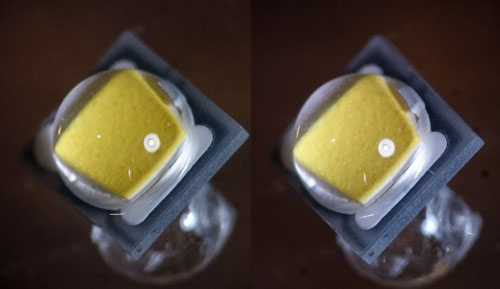
The Nichia 219C is the newest upgrade in the 219 series. The Nichia 219 leds have become famous for their 90+ CRI variants, giving better colour reproduction than any Cree or other led, but in the performance section they were way behind Cree at start. But since back then the 219 has come a long way: the 219B performed way better than the 219A, and this test shows another huge leap with the 219C.
The 90+ CRI versions of the 219C are not on the market yet, but I was able to purchase this Nichia 5000K 83CRI B280-300 led from Lumitronics in Germany (the picture on the site is wrong btw). Voltage and current performances from this test will be comparable for the upcoming high CRI variants (when time comes, I want to test them as well for output and colour performance), but for now let’s see how this 5000K 83CRI led compares to a latest bin XP-G2 
The Nichia was reflowed on a 16mm Noctigon board and tested for voltage and output using my usual method, described in the XP-L test-thread, except that for this test my 46cm integrating sphere was used (should not make a difference for the results). Also I tested a Cree XP-G2 S4 2B led, for comparison and also because I have thusfar only tested lower binned XP-G2’s and the newer XP-G2’s are said to have higher voltages (and higher output of course).
For the graphically challenged, here are the raw collected data from the tests, also because I find the actual numbers always very useful for reference (in blueish green the Nichia numbers, in greenish green the XP-G2 numbers):

For comparison, in the graph I added some already posted test data (collected with the exact same method): for the Nichia219B 4500K 90+CRI, the new Osram Oslon Square 4000K 90+CRI, and an old batch cool white XP-G2 R5. Note that output differences are partly a result of varying colour temprature and CRI of the different leds in the graph.

So what can be seen?
*I have put way to many lines in this graph, I hope you can make things out 
*the output of the 219C is very very good, close to the (cooler tinted and lower CRI) latest XP-G2! The maximum at 6.2A is the same as the XP-G2, so Nichia has (silently) managed to achieve the same low thermal resistance as Cree. And look at the difference with the 219B (maximum at 3.8V), this is a huge leap again.
*the 219C has the lowest voltage of the bunch, and so much lower than the XP-G2 that it is more efficient at all currents. The voltage is even significantly lower than the Cree XM-L2 (0.25V ! lower at 6A). This makes the 219C very easy to use in single li-ion flashlights, it will even require current regulation (polish up your Qlites!), with FET-drivers it may draw more current than you would like!
*I really tried, but could not kill the 219C, I stopped at 10A. After that I looked for decreased performance, checked at 4.4A, and found just 2.5% less output. This could be caused by what looks from the side like a semi-detached dome (led at .5mA). Having been at 10A for 2 minutes, I can not blame this led  :
:

*the 92CRI new Oslon Square that I tested recently, outperformed the Nichia 219B, but compared to the 219C the Oslon will probably loose it (but a definite answer is there when the 92CRI 219C becomes available).
*this XP-G2 S4 2B has a fairly constant 0.2V higher voltage than this old batch XP-G2 R5 over most of the current range. This is consistent with the general observation on the newer Cree leds.
With these results I am curious about the dedomed performance of the 219C. The XP-G2 still has the advantage of a bit better output and of a bit smaller die size (1.45x1.45mm, compared to 1.6x1.6mm for the 219), but I really like the uniformity of the 219C die for use in aspherics:
 (here at 0.5mA, and after the torture)
(here at 0.5mA, and after the torture)
Conclusion
The Nichia 219C seems a fantastic upgrade over the 219B, in performance, voltage and thermal resistance. I’m also really looking forward to the 90+ CRI variants. As already said in the new Oslon Square test: it is high time that Cree launches a new generation XP-G2.
Thanks for reading!
 (stereo picture)
(stereo picture)
 )
)


 :
:
 (here at 0.5mA, and after the torture)
(here at 0.5mA, and after the torture) (stereo picture)
(stereo picture) . You will (may) find buried in there a whole section dedicated to djozz's tests, all the thread links - I'm guessing it's bout 1/4 the way into it.
. You will (may) find buried in there a whole section dedicated to djozz's tests, all the thread links - I'm guessing it's bout 1/4 the way into it.